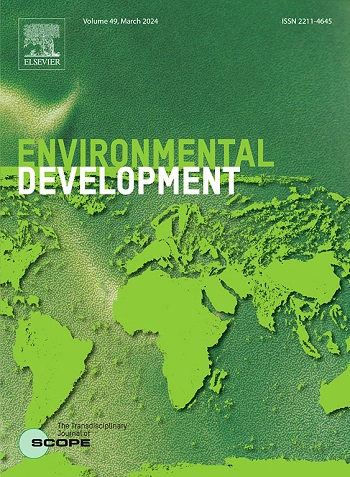绿色空间对文化生态系统服务的利用与感知——以印度加尔各答特大城市地区为例
IF 5.3
2区 环境科学与生态学
Q2 ENVIRONMENTAL SCIENCES
引用次数: 0
摘要
绿色空间提供重要的文化生态系统服务(ES),这些ES对人类健康和福祉至关重要。但城市中的绿地正日益受到快速城市化的威胁,尤其是在发展中国家。本研究旨在探讨加尔各答特大城市地区(KMR)绿地中文化ES的使用和感知。采用Kruskal-Wallis检验、相关分析、层次聚类分析和主成分分析(PCA)等统计分析方法对绿色空间的生态系统使用模式和感知模式进行了评估。结果表明,绿色空间的主要价值在于娱乐、社交、美学和健康益处。娱乐体验与社会关系(0.868,0.775)、灵感(0.878,0.751)、审美(0.896,0.83)、地方感(0.987,0.851)、健康(0.78,0.853)呈显著正相关。分层聚类结果表明,Rabindra Sarabor地区58.33%的ES属于第2类,而生态园在第1类中所占比例最高(37.50%)。主成分分析表明,PC1和PC2解释了Rabindra Sarabor的69%和31%的总方差,而Eco Park的总方差为54%。研究结果强调了将文化ES纳入城市规划以提高人类福祉的重要性。策略性景观管理可以确保这些空间的可持续性,促进社区参与和环境弹性。本文章由计算机程序翻译,如有差异,请以英文原文为准。

Use and perception of cultural ecosystem services from green spaces: A case from Kolkata Megacity Region (India)
Green spaces offer vital cultural ecosystem services (ES), and these ES are essential for human health and well-being. But the green spaces in cities are increasingly threatened by rapid urbanization, particularly in developing countries. This study aims to explore the use and perception of cultural ES from green spaces in Kolkata Megacity Region (KMR). A number of statistical analyses such as Kruskal-Wallis test, Correlation Analysis, Hierarchical Cluster Analysis, and Principal Component Analysis (PCA), were applied to assess patterns of ES use and perceptions from green spaces. The results showed that green spaces were primarily valued for recreation, social interactions, aesthetics, and health benefits. Recreation ES showed strong correlations with social relations (0.868, 0.775), inspiration (0.878, 0.751), aesthetics (0.896, 0.83), sense of place (0.987, 0.851), and health (0.78, 0.853). Hierarchical clustering revealed that 58.33% of ES in Rabindra Sarabor fell into Cluster 2, while Eco Park had the highest share in Cluster 1 (37.50 %). PCA indicated that PC1 and PC2 explained 69 % and 31 % of the variance in Rabindra Sarabor, while Eco Park showed 54% total variance. The findings highlight the importance of integrating cultural ES into urban planning for enhanced human well-being. Strategic landscape management can ensure the sustainability of these spaces, fostering community engagement and environmental resilience.
求助全文
通过发布文献求助,成功后即可免费获取论文全文。
去求助
来源期刊

Environmental Development
Social Sciences-Geography, Planning and Development
CiteScore
8.40
自引率
1.90%
发文量
62
审稿时长
74 days
期刊介绍:
Environmental Development provides a future oriented, pro-active, authoritative source of information and learning for researchers, postgraduate students, policymakers, and managers, and bridges the gap between fundamental research and the application in management and policy practices. It stimulates the exchange and coupling of traditional scientific knowledge on the environment, with the experiential knowledge among decision makers and other stakeholders and also connects natural sciences and social and behavioral sciences. Environmental Development includes and promotes scientific work from the non-western world, and also strengthens the collaboration between the developed and developing world. Further it links environmental research to broader issues of economic and social-cultural developments, and is intended to shorten the delays between research and publication, while ensuring thorough peer review. Environmental Development also creates a forum for transnational communication, discussion and global action.
Environmental Development is open to a broad range of disciplines and authors. The journal welcomes, in particular, contributions from a younger generation of researchers, and papers expanding the frontiers of environmental sciences, pointing at new directions and innovative answers.
All submissions to Environmental Development are reviewed using the general criteria of quality, originality, precision, importance of topic and insights, clarity of exposition, which are in keeping with the journal''s aims and scope.
 求助内容:
求助内容: 应助结果提醒方式:
应助结果提醒方式:


